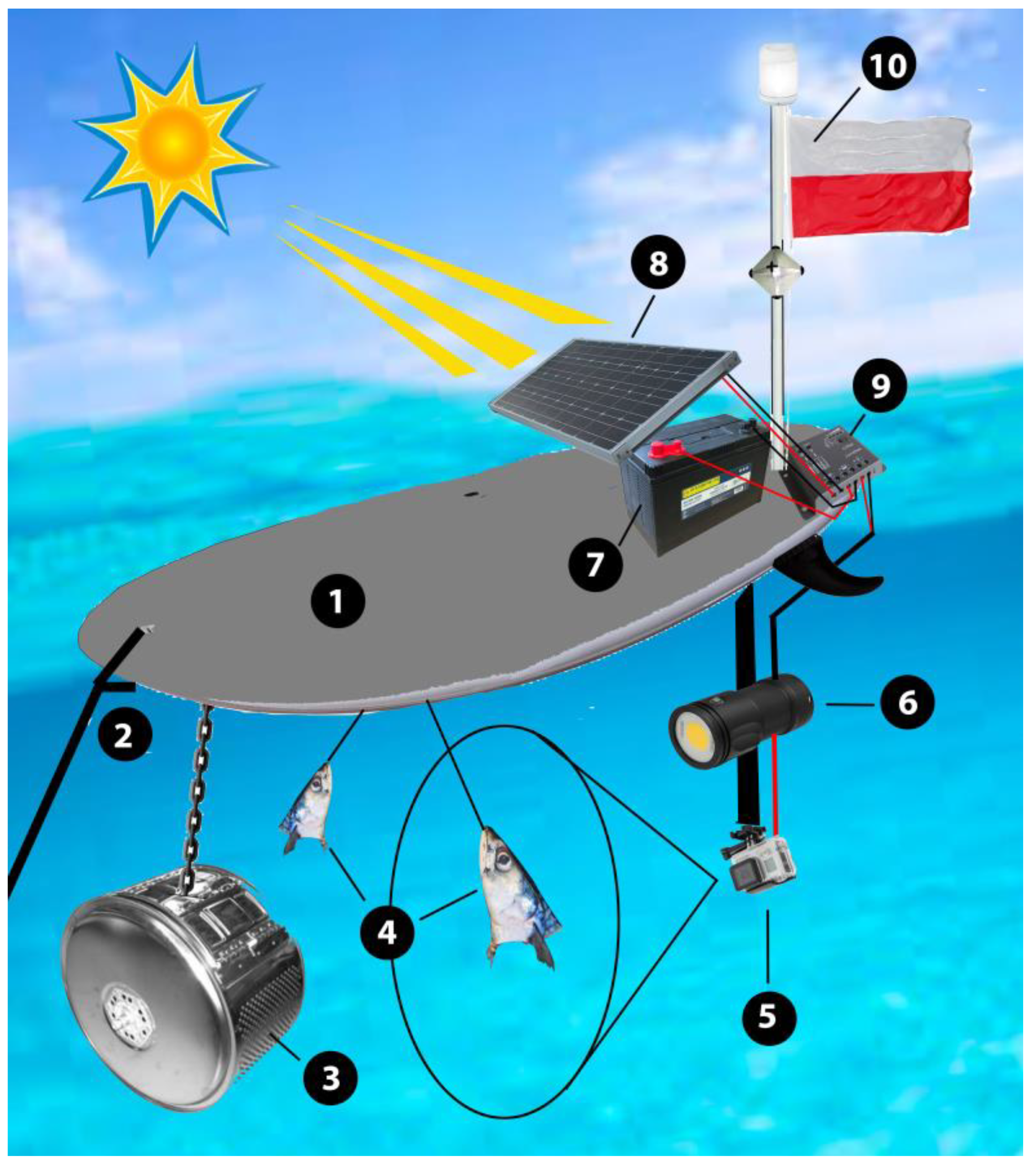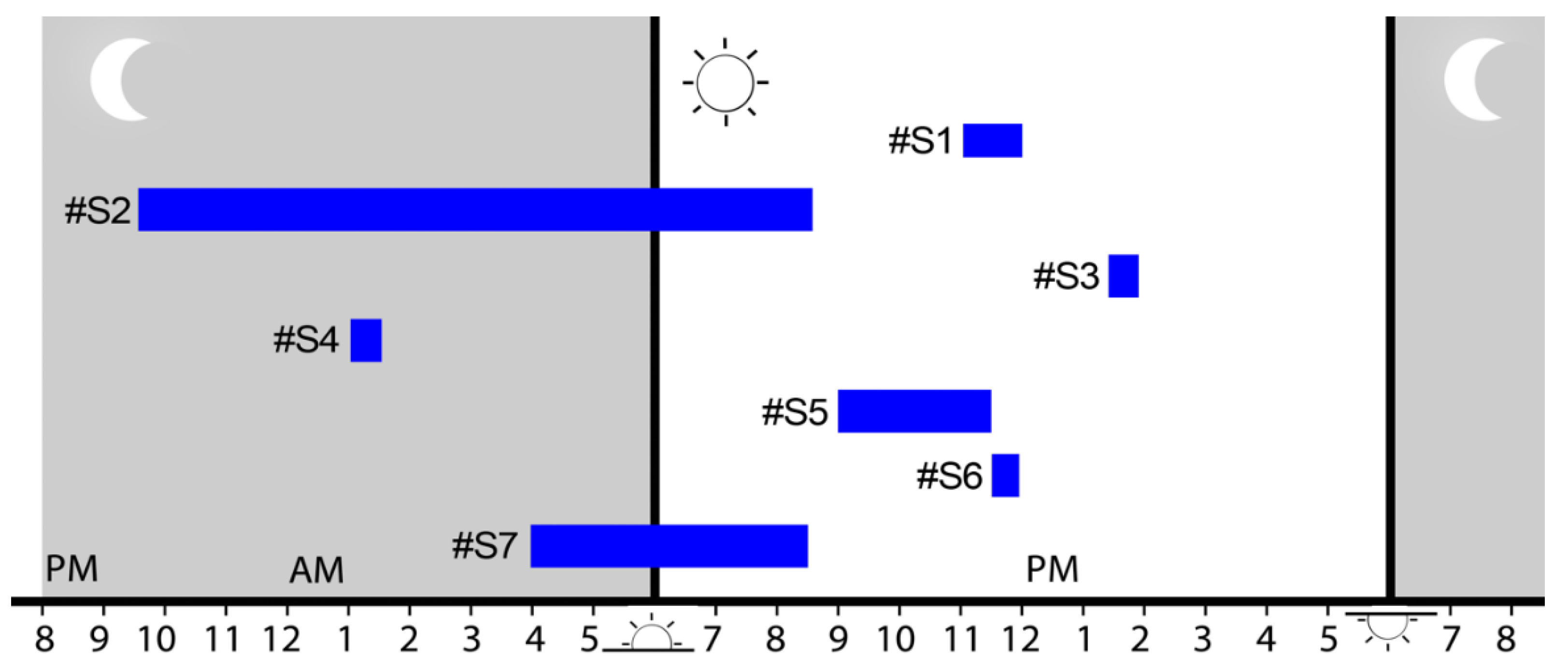A Time-Extended (24 h) Baited Remote Underwater Video (BRUV) for Monitoring Pelagic and Nocturnal Marine Species
Abstract
1. Introduction
2. Material and Methods
2.1. Study Site and Sampling Effort
2.2. Method for Shark Attraction and Video Recording
3. Results
4. Discussion
Author Contributions
Funding
Acknowledgments
Conflicts of Interest
Appendix A
| ITEM | Approx. Price in $US |
| 1. Surfboard: (potentially recycled)* | 300 |
| 2. Anchor, rope and buoy | 30 |
| 3. Washing machine drum: (potentially recycled)* | 100 |
| 4. Gopro Hero 3+ | 190 |
| 5. 256 Gb Mini SD memory card (needs 2) | 40 |
| 6. Monitor and external power connector | 15 |
| 7. Underwater video light | 60 |
| 8. 12 V 60 Ah AGM Battery | 108 |
| 9. Solar pannel | 24 |
| 10. Gharge controller | 13 |
| 11. Flag, white position light and radar reflector | 50 |
| 12. Protection alluminum box | 90 |
| 13. Easy access inox camera and light support | 90 |
| 14. 22 mm plastic mast base | 6 |
| 15. 20 mm alluminum mast | 12 |
| 16. Inox chain and shackles | 40 |
| TOTAL (with all components) | 1070 |
| TOTAL* (including recycled components) | 670 |
References
- Ellis, D.; DeMartini, E. Evaluation of a video camera technique for indexing abundances of juvenile pink snapper, Pristipomoides filamentosus, and other Hawaiian insular shelf fishes. Fish. Bull. 1995, 93, 67–77. [Google Scholar]
- Harvey, E.; Shortis, M. A system for stereo video measurement of sub-tidal organisms. Mar. Technol. Soc. J. 1995, 29, 10–22. [Google Scholar]
- Langlois, T.J.; Harvey, E.S.; Fitzpatrick, B.; Meeuwig, J.J.; Shedrawi, G.; Watson, D.L. Cost-efficient sampling of fish assemblages: Comparison of baited video stations and diver video transects. Aquat. Biol. 2010, 9, 155–168. [Google Scholar] [CrossRef]
- Mallet, D.; Pelletier, D. Underwater video techniques for observing coastal marine biodiversity: A review of sixty years of publications (1952–2012). Fish. Res. 2014, 154, 44–62. [Google Scholar] [CrossRef]
- Andradi-Brown, D.A.; Macaya-Solis, C.; Exton, D.A.; Gress, E.; Wright, G.; Rogers, A.D. Assessing Caribbean shallow and mesophotic reef fish communities using baited-remote underwater video (BRUV) and diver-operated video (DOV) survey techniques. PLoS ONE 2016, 11, e0168235. [Google Scholar] [CrossRef]
- Kiggins, R.S.; Knott, N.A.; Davis, A.R. Miniature Baited remote underwater video (mini-BRUV) reveals the response of cryptic fishes to seagrass cover. Environ. Biol. Fishes 2018, 101, 1717–1722. [Google Scholar] [CrossRef]
- Roberts, L.; Pérez-Domínguez, R.; Elliott, M. Use of Baited remote underwater video (BRUV) and motion analysis for studying the impacts of underwater noise upon free ranging fish and implications for marine energy management. Mar. Pollut. Bull. 2016, 112, 75–85. [Google Scholar] [CrossRef]
- Ghazilou, A.; Shokri, M.R.; Gladstone, W. Animal v. plant-based bait: Does the bait type affect census of fish assemblages and trophic groups by Baited remote underwater video (BRUV) systems? J. Fish. Biol. 2016, 88, 1731–1745. [Google Scholar] [CrossRef]
- Brena, P.F.; Mourier, J.; Planes, S.; Clua, E. Shark and ray provisioning: Functional insights into behavioral, ecological and physiological responses across multiple scales. Mar. Ecol. Prog. Ser. 2015, 538, 273–283. [Google Scholar] [CrossRef]
- FINPRINT Project (2019). Available online: https://globalfinprint.org/ (accessed on 2 January 2020).
- Spaet, J.L.; Nanninga, G.B.; Berumen, M.L. Ongoing decline of shark populations in the Eastern Red Sea. Biol. Conserv. 2016, 201, 20–28. [Google Scholar] [CrossRef]
- Speed, C.W.; Rees, M.J.; Cure, K.; Vaughan, B.; Meekan, M.G. Protection from illegal fishing and shark recovery restructures mesopredatory fish communities on a coral reef. Ecol. Evol. 2019, 9, 10553–10566. [Google Scholar] [CrossRef]
- Heithaus, M.R.; Frid, A.; Wirsing, A.J.; Worm, B. Predicting ecological consequences of marine top predator declines. Trends Ecol. Evol. 2008, 23, 202–210. [Google Scholar] [CrossRef]
- Ferretti, F.; Myers, R.A.; Serena, F.; Lotze, H.K. Patterns and ecosystem consequences of shark declines in the ocean. Ecol. Lett. 2010, 13, 1055–1071. [Google Scholar] [CrossRef]
- Ferretti, F.; Myers, R.A.; Serena, F.; Lotze, H.K. Loss of large predatory sharks from the Mediterranean Sea. Conserv. Biol. 2008, 22, 952–964. [Google Scholar] [CrossRef]
- Morey, G.; Martinez, M.; Massuti, E.; Moranta, J. The occurrence of white sharks, Carcharodon carcharias, around the Balearic Islands (western Mediterranean Sea). Environ. Biol. Fishes 2003, 68, 425–432. [Google Scholar] [CrossRef]
- Morey, G.; Massti, E. Record of the copper shark, Carcharhinus brachyurus, from the Balearic Islands (Western Mediterranean). Cybium 2003, 27, 53–56. [Google Scholar]
- Morey, G.; Soldo, A.; Riera, F.; Serena, F. Records of Carcharhinus limbatus and C. plumbeus (Chondrichthyes: Carcharhinidae) from off the Balearic Islands (NW Mediterranean). Cybium 2008, 32, 195–200. [Google Scholar]
- Last, P.R.; Stevens, J.D. Sharks and Rays of Australia, 2nd ed.; CSIRO: Melbourne, Australia, 2009. [Google Scholar]
- Gubanov, Y.P.; Grigor’yev, V.N. Observations on the distribution and biology of the Blue shark Prionace glauca (Carcharhinidae) of the Indian Ocean. J. Ichthyol. 1975, 15, 37–43. [Google Scholar]
- Castro, J.A.; Mejuto, J. Reproductive parameters of Blue shark, Prionace glauca, and other sharks in the Gulf of Guinea. Mar. Freshw. Res. 1995, 46, 967–973. [Google Scholar] [CrossRef]
- Biton-Porsmoguer, S.; LLoret, J. Potentially unsustainable fisheries of a critically-endangered pelagic shark species: The case of the Blue shark (Prionace glauca) in the Western Mediterranean Sea. Cybium 2018, 42, 299–302. [Google Scholar]
- Dulvy, N.K.; Allen, D.L.; Ralph, G.M.; Walls, R.H.L. The Conservation Status of Sharks, Rays and Chimae¬ras in the Mediterranean Sea; IUCN: Málaga, Spain, 2016; 14p. [Google Scholar]
- Stevens, J.D.; Bradford, R.W.; West, G.J. Satellite tagging of Blue sharks (Prionace glauca) and other pelagic sharks off eastern Australia: Depth behaviour, temperature experience and movements. Mar. Biol. 2010, 157, 575–591. [Google Scholar] [CrossRef]
- Vas, P. The abundance of the Blue shark, Prionace glauca, in the western English Channel. Environ. Biol. Fishes 1990, 29, 209–225. [Google Scholar] [CrossRef]
- Clarke, M.R.; Stevens, J.D. Cephalopods, Blue sharks and migration. J. Mar. Biol. Assoc. UK 1974, 54, 949–957. [Google Scholar] [CrossRef]
- Boldrocchi, G.; Kiszka, J.; Purkis, S.; Storai, T.; Zinzula, L.; Burkholder, D. Distribution, ecology, and status of the white shark, Carcharodon carcharias, in the Mediterranean Sea. Rev. Fish. Biol. Fish. 2017, 27, 515–534. [Google Scholar] [CrossRef]
- Gouraguine, A.; Hidalgo, M.; Moranta, J.; Bailey, D.M.; Ordines, F.; Guijarro, B.; De Mesa, A. Elasmobranch spatial segregation in the western Mediterranean. Sci. Mar. 2011, 75, 653–664. [Google Scholar]
- Deudero, S.; Morales-Nin, B. Occurrence of Polyprion americanus under floating objects in western Mediterranean oceanic waters, inference from stomach contents analysis. J. Mar. Biol. Assoc. UK 2000, 80, 751–752. [Google Scholar] [CrossRef]
- Torres, P.; Bolhão, N.; Da Cunha, R.T.; Vieira, J.A.C.; Dos Santos Rodrigues, A. Dead or alive: The growing importance of shark diving in the Mid-Atlantic region. J. Nat. Conserv. 2017, 36, 20–28. [Google Scholar] [CrossRef]



| Location | Coordinates | Depth (m) | Average Temp. (°C) | Dist. To Coast (Nm) | Starting Date | Ending Date | Day Hours | Night Hours | |
|---|---|---|---|---|---|---|---|---|---|
| Mallorca | Canal Menorca | N 39°42′407/E 03°45′014 | 90 | 25 | 24.1 | 09/07/2017 | 11/07/2017 | 36:38:00 | 18:22:00 |
| Cap Vermeil | N 39°39′244/E 03°29′946 | 50 | 15 | 3.7 | 02/01/2018 | 05/01/2018 | 35:18:00 | 43:42:00 | |
| Bahía de Palma | N 39°29′37.6″/E 02°41′54 | 30 | 15 | 0.6 | 23/01/2018 | 25/01/2018 | 26:48:00 | 28:12:00 | |
| Bahía de Pollença | N 39°56′26.2″/E 03°11′49 | 40 | 14 | 3.7 | 12/03/2018 | 17/03/2018 | 65:55:00 | 61:05:00 | |
| Puerto de Sóller | N 39°51′230/E 02°38′838 | 80 | 23 | 4.1 | 21/06/2018 | 26/06/2018 | 81:55:00 | 45:05:00 | |
| N 39°51′230/E 02°38′838 | 80 | 26 | 7.4 | 17/07/2018 | 19/07/2018 | 36:19:00 | 18:40:00 | ||
| Cabo Formentor | N 39°57,940/E 03°14,011 | 66 | 16 | 2.0 | 24/12/2018 | 29/12/2018 | 53:50:00 | 73:10:00 | |
| Puerto de Sóller | N 39°49.794/E 02°39′921 | 65 | 14 | 7.4 | 12/02/2019 | 18/02/2019 | 52:36:00 | 86:24:00 | |
| Porto Colom | N 39°23,110/E 03°17,311 | 55 | 14 | 3.0 | 10/03/2019 | 14/03/2019 | 43:09:00 | 49:16:00 | |
| Font de sa Cala | N 39°38,666/E 03°37,982 | 90 | 26 | 15.4 | 03/07/2019 | 13/07/2019 | 147:10:00 | 90:50:00 | |
| N 39°39.428′/E 03°38,328 | 90 | 22 | 15.4 | 27/10/2019 | 02/11/2019 | 62:10:00 | 79:48:00 | ||
| Menorca | Sa Mezquida | N 39°56,023/E 04°22,260 | 130 | 27 | 7.4 | 15/08/2019 | 20/08/2019 | 66:55:00 | 51:15:00 |
| Total | 708:43:00 | 645:49:00 |
| Shark ID | Session | Gender | Length Estimate | Special Markings |
|---|---|---|---|---|
| #1 | Canal Menorca | F | 2 m | No residual hook. No specific marking. |
| #2 | Puerto Soler 1 | M | 1.5 m | Residual hook (right side) with a nylon leader that exceeded the shark length by <2m. |
| #3 | F | 1.2 m | Residual hook (right side) with a nylon leader that exceeded the shark length by >2m. | |
| #4 | M | 1.5 m | No residual hook (compared to S#2). Sub-terminal notch on the tale less pro-eminent than S#2. | |
| #5 | M | 2 m | Different gender from other animals of similar size (S#1 and S#7). | |
| #6 | Puerto Soler 2 | F | 1.6 m | Different gender from other animals of similar size (S#2 and S#4). |
| #7 | Font de Sa Cala | F | 2 m | Residual hook (right side) with heavy algal fouling and without nylon leader. |
© 2020 by the authors. Licensee MDPI, Basel, Switzerland. This article is an open access article distributed under the terms and conditions of the Creative Commons Attribution (CC BY) license (http://creativecommons.org/licenses/by/4.0/).
Share and Cite
Torres, A.; Abril, A.-M.; Clua, E.E.G. A Time-Extended (24 h) Baited Remote Underwater Video (BRUV) for Monitoring Pelagic and Nocturnal Marine Species. J. Mar. Sci. Eng. 2020, 8, 208. https://doi.org/10.3390/jmse8030208
Torres A, Abril A-M, Clua EEG. A Time-Extended (24 h) Baited Remote Underwater Video (BRUV) for Monitoring Pelagic and Nocturnal Marine Species. Journal of Marine Science and Engineering. 2020; 8(3):208. https://doi.org/10.3390/jmse8030208
Chicago/Turabian StyleTorres, Agusti, Ana-Maria Abril, and Eric E. G. Clua. 2020. "A Time-Extended (24 h) Baited Remote Underwater Video (BRUV) for Monitoring Pelagic and Nocturnal Marine Species" Journal of Marine Science and Engineering 8, no. 3: 208. https://doi.org/10.3390/jmse8030208
APA StyleTorres, A., Abril, A.-M., & Clua, E. E. G. (2020). A Time-Extended (24 h) Baited Remote Underwater Video (BRUV) for Monitoring Pelagic and Nocturnal Marine Species. Journal of Marine Science and Engineering, 8(3), 208. https://doi.org/10.3390/jmse8030208






